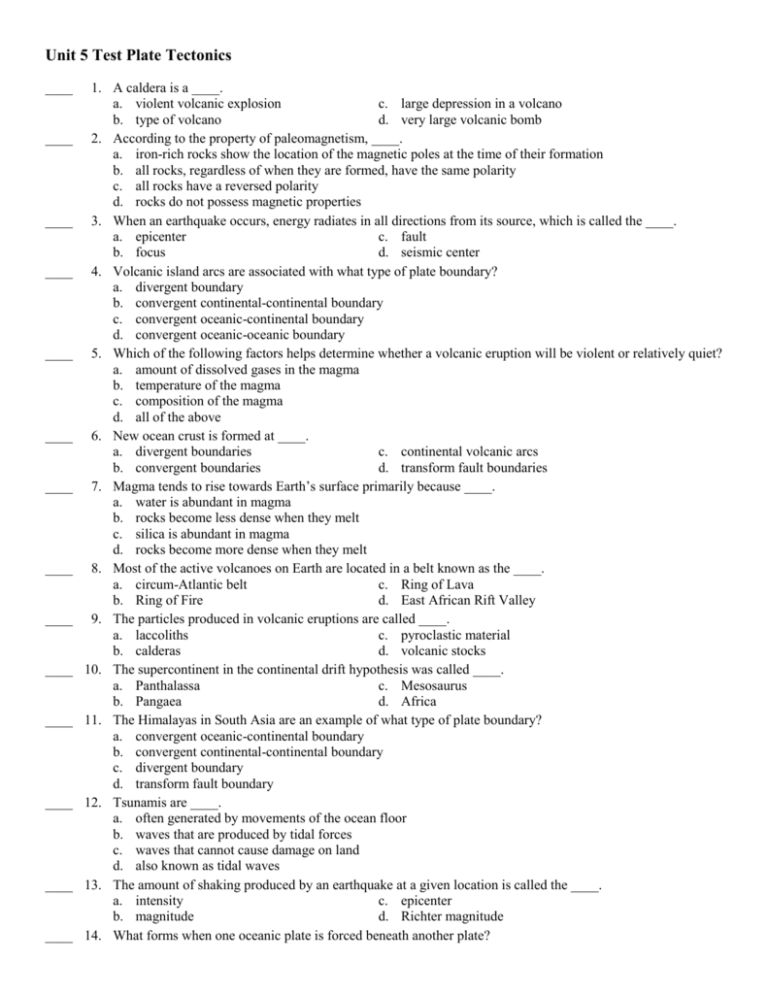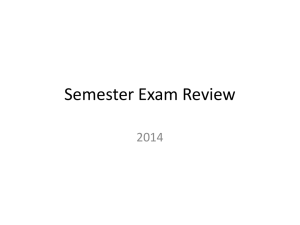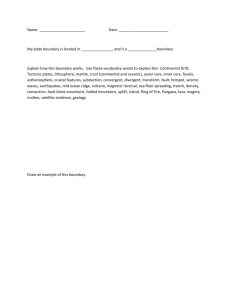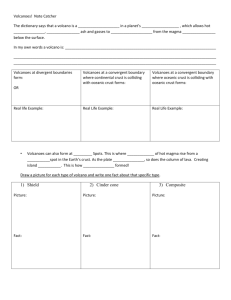Unit 5 Test Plate Tectonics
advertisement

Unit 5 Test Plate Tectonics ____ ____ ____ ____ ____ ____ ____ ____ ____ ____ ____ ____ ____ ____ 1. A caldera is a ____. a. violent volcanic explosion c. large depression in a volcano b. type of volcano d. very large volcanic bomb 2. According to the property of paleomagnetism, ____. a. iron-rich rocks show the location of the magnetic poles at the time of their formation b. all rocks, regardless of when they are formed, have the same polarity c. all rocks have a reversed polarity d. rocks do not possess magnetic properties 3. When an earthquake occurs, energy radiates in all directions from its source, which is called the ____. a. epicenter c. fault b. focus d. seismic center 4. Volcanic island arcs are associated with what type of plate boundary? a. divergent boundary b. convergent continental-continental boundary c. convergent oceanic-continental boundary d. convergent oceanic-oceanic boundary 5. Which of the following factors helps determine whether a volcanic eruption will be violent or relatively quiet? a. amount of dissolved gases in the magma b. temperature of the magma c. composition of the magma d. all of the above 6. New ocean crust is formed at ____. a. divergent boundaries c. continental volcanic arcs b. convergent boundaries d. transform fault boundaries 7. Magma tends to rise towards Earth’s surface primarily because ____. a. water is abundant in magma b. rocks become less dense when they melt c. silica is abundant in magma d. rocks become more dense when they melt 8. Most of the active volcanoes on Earth are located in a belt known as the ____. a. circum-Atlantic belt c. Ring of Lava b. Ring of Fire d. East African Rift Valley 9. The particles produced in volcanic eruptions are called ____. a. laccoliths c. pyroclastic material b. calderas d. volcanic stocks 10. The supercontinent in the continental drift hypothesis was called ____. a. Panthalassa c. Mesosaurus b. Pangaea d. Africa 11. The Himalayas in South Asia are an example of what type of plate boundary? a. convergent oceanic-continental boundary b. convergent continental-continental boundary c. divergent boundary d. transform fault boundary 12. Tsunamis are ____. a. often generated by movements of the ocean floor b. waves that are produced by tidal forces c. waves that cannot cause damage on land d. also known as tidal waves 13. The amount of shaking produced by an earthquake at a given location is called the ____. a. intensity c. epicenter b. magnitude d. Richter magnitude 14. What forms when one oceanic plate is forced beneath another plate? ____ 15. ____ 16. ____ 17. ____ 18. ____ 19. ____ 20. ____ 21. ____ 22. ____ 23. ____ 24. ____ 25. ____ 26. ____ 27. a. an ocean basin c. a subduction zone b. an ocean ridge d. a rift valley Continental volcanic arcs are associated with what type of plate boundary? a. convergent continental-continental boundary b. convergent oceanic-continental boundary c. transform fault boundary d. convergent oceanic-oceanic boundary Which of the following was NOT used in support of the continental drift hypothesis? a. fossil evidence c. ancient climate b. paleomagnetism d. fit of South America and Africa Which of the following causes earthquakes? a. elastic rebound c. release of heat b. Richter scale d. frictional heating Major earthquakes are sometimes preceded by smaller earthquakes called ____. a. aftershocks c. surface waves b. focus shocks d. foreshocks A divergent boundary at two oceanic plates can result in a ____. a. rift valley c. continental volcanic arc b. volcanic island arc d. subduction zone Magma forms when solid rock in the crust and upper mantle ____. a. melts c. crystallizes b. vaporizes d. cools What kind of plate boundary occurs where two plates grind past each other without destroying or producing lithosphere? a. divergent boundary c. transitional boundary b. convergent boundary d. transform fault boundary Lava plateaus form when ____. a. the top of a volcano collapses b. fluid basaltic lava flows out of fissures c. lahars create new landforms d. pyroclastic flows erupt from volcanoes Which of the following is NOT a factor affecting how violently or quietly a volcano erupts? a. magma’s composition b. magma’s temperature c. concentration of dissolved gases in the magma d. size of the volcano’s cone Which type of landform develops at plate boundaries where one oceanic plate descends beneath another? a. rift valley b. volcanic island arc c. mountain ranges formed by a batholith d. lava plateau Which seismic waves travel most rapidly? a. P waves c. surface waves b. S waves d. tsunamis Wegener’s continental drift hypothesis stated that all the continents once joined together to form ____. a. two major supercontinents b. two major supercontinents and three smaller continents c. one major supercontinent d. three major supercontinents Highly explosive volcanoes tend to have what type of magma? a. magma with high silica, high viscosity, and higher gas content b. magma with low silica, low viscosity, and lower gas content c. magma with low silica, high viscosity, and lower gas content d. magma with no silica, high viscosity, and no gas content ____ 28. What was the main reason Wegener’s continental drift hypothesis was rejected? a. He was not well liked by other scientists. b. He could not provide a mechanism for the movement of the continents. c. He could provide only illogical explanations for the movement of the continents. d. His evidence was incorrect. ____ 29. The geographic distribution of the swimming reptile Mesosaurus provides evidence that ____. a. Europe was covered by a shallow sea when Mesosaurus lived b. a land bridge existed between Australia and India c. South America and Africa were once joined d. the Atlantic Ocean was wider when Mesosaurus lived than it is now ____ 30. An earthquake’s epicenter is ____. a. the place on the surface directly above the focus b. a spot halfway between the focus and the surface c. the spot below the focus d. any spot along the nearest fault ____ 31. The broad, slightly dome-shaped volcanoes of Hawaii are ____. a. composite cone volcanoes c. pyroclastic volcanoes b. shield volcanoes d. cinder cone volcanoes ____ 32. The Hawaiian Islands were formed when the Pacific Plate moved over ____. a. a subduction zone c. the Aleutian Plate b. an ocean ridge d. a hot spot ____ 33. Which of the following affects the amount of destruction caused by earthquake vibrations? a. the design of structures b. the intensity and duration of the vibrations c. the nature of the material on which structures are built d. all of the above ____ 34. What type of volcano is built almost entirely from ejected lava fragments? a. cinder cone c. shield volcano b. composite cone d. pahoehoe volcano ____ 35. A fault is ____. a. a place on Earth where earthquakes cannot occur b. a fracture in the Earth where movement has occurred c. the place on Earth’s surface where structures move during an earthquake d. another name for an earthquake ____ 36. In general, an increase in the confining pressure results in what change in a rock’s melting temperature? a. Melting temperature stays the same. b. Melting temperature decreases. c. Melting temperature increases. d. Melting temperature is not related to confining pressure. ____ 37. The scale most widely used by scientists for measuring earthquakes is the ____. a. seismic scale c. moment magnitude scale b. Richter scale d. epicenter magnitude scale ____ 38. One kind of evidence that supports Wegener’s hypothesis is that ____. a. the same magnetic directions exist on different continents b. major rivers on different continents match c. land bridges still exist that connect major continents d. fossils of the same organism have been found on different continents ____ 39. What type of boundary occurs where two plates move together, causing one plate to descend into the mantle beneath the other plate? a. transform fault boundary c. convergent boundary b. divergent boundary d. transitional boundary ____ 40. Earth’s thin, rocky outer layer is its ____. a. core c. outer core b. mantle d. crust ____ 41. Overall, which seismic waves are the most destructive? a. P waves c. compression waves b. S waves d. surface waves ____ 42. What instrument records earthquake waves? a. seismogram c. Richter scale b. seismograph d. barometer 43. Which of the following is the best evidence that Earth’s continents were once in vastly different positions than they are today? A Penguins are found only in the Southern Hemisphere. B Fossils of tropical plants are found in Antarctica. C Volcanoes encircle the Pacific Ocean. D Major rivers form deltas from continental erosion. 44. Which of the following provides evidence for plate tectonics? A sea-floor topography B ocean currents C Coriolis effect D atmospheric temperatures 45. The convergence of two continental plates would produce A island arcs. B rift valleys. C folded mountains. D trenches. 46. Which of the following is most responsible for the formation of new crust at the edge of a tectonic plate? A mountain building at a continent-continent convergent boundary B magma rising up from the mantle at a divergent boundary C two tectonic plates sliding past one another at a transform boundary D subduction of one oceanic plate under another at a convergent boundary 47. Earthquake vibrations are detected, measured, and recorded by instruments called A sonargraphs.B seismographs.C Richter scales.D magnetometers. Diagram A 48. In Diagram A, at which location would earthquakes be least likely to occur? A1 B2 C3 D4 49. Which type of volcano would be the least explosive? A cinder cone B stratovolcano C shield volcano D composite cone 50. Scientists have found fossils of tropical plants in Antarctica. How could tropical plants have grown in Antarctica? A At one time, Earth’s entire surface was a tropical rain forest. B At one time, Antarctica was located closer to the equator. C The rotation of Earth has increased, causing cooling of the atmosphere. D Catastrophic volcanic eruptions melted the ice and exposed the soil to sunlight.







